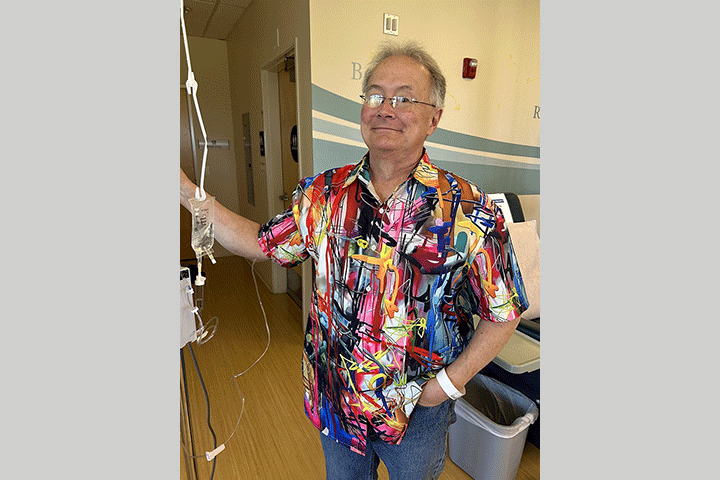A New Treatment Leads to a Whipple Procedure

- Switching to pancreatic cancer specialists
- Using FOLFIRINOX, a new combination
- Genetic testing in case the cancer returns
By the Spring of 2011 I had been having trouble with my stomach for six months. The sourness had responded to medication at one point, but the medication no longer helped.
I thought I had the flu. But when the cold cleared up in a few days, my stomach still felt bad and I called my doctor. At the hospital, I was diagnosed with pancreatic cancer and was scheduled for a Whipple procedure. A biopsy was not done given the location of the pancreas and the fear that a biopsy would be counterproductive.
I decided to go to Memorial Sloan Kettering (MSK) in New York for more tests. There I had an endoscopy procedure that involved an ultra-sound of the tumor, a biopsy of the tumor, and a stent placed in my bile duct so that it could drain. I was officially diagnosed with stage IIIB pancreatic cancer (adenocarcinoma) a week after my 50th birthday, in April 2011.
Developing a Treatment Plan
At MSK, the team of Dr. Eileen O’Reilly, Dr. Peter Allen (now at Duke University School of Medicine), and Dr. Karyn Goodman (now at Mount Sinai, New York), weren’t certain surgery would be successful—whether the tumor could be successfully removed from a blood vessel. They prescribed four sessions of FOLFIRINOX to be followed by a CT scan. After this we would make a decision on the next course of treatment.
As I understand it, findings about FOLFIRINOX had just been highlighted at the annual meeting on cancer research, and while toxic, it had been shown to be more effective than gemcitabine for otherwise healthy pancreatic cancer patients. Giving me FOLFIRINOX was not the standard procedure, especially before surgery (although it is becoming so now), but the hope was that they could get me to the operating table. At the time, FOLFIRINOX was new, and it was not the standard treatment protocol before or after surgery.
As it was explained to me, pancreatic cancer couldn’t be cured with chemotherapy. But if I responded well to the treatments, and the tumor shrunk, I could have a Whipple procedure and have a chance of surviving. If the tumor didn’t respond to FOLFIRINOX, the next course of treatment would have been radiation. Fortunately, I responded to the chemotherapy.
Other than the cancer, I was healthy. I’d read enough about pancreatic cancer to know that it didn’t appear to be a chronic disease, so you needed to be as aggressive as possible to beat it . . . and you had to be lucky. I was lucky that the disease had presented itself before it had metastasized, and lucky that it responded to the chemotherapy.
Qualifying For the Whipple Procedure
The team of doctors at MSK wanted to be aggressive, and I’m fortunate they did because my body responded well to FOLFIRINOX. My tumor shrunk dramatically, allowing me to undergo a Whipple procedure that July. After a few weeks of recovery, I went back for eight treatments of FOLFIRINOX; this took me to Thanksgiving. Starting in late December of 2011, I underwent eight weeks of radiation. In all, I finished the formal treatments 11 months after diagnosis. My doctors and I discussed additional treatments, but each time we decided against them, awaiting further evidence that they proved helpful.
I had some side effects: neuropathy from the FOLFIRINOX, and post-Whipple eating/stomach issues, but nothing that was more than a nuisance. In time, the neuropathy almost completely disappeared. And my stomach has gotten better with time; my use of enzymes to help digestion has diminished almost completely, though I still have to be careful about what I eat.
Testing my Tumor After Surgery
After the Whipple I donated my tumor for testing. During my recovery, there were a number of times that the radiologists diagnosed a return of my cancer. Each time proved to be a false alarm, but in the fourth year following my diagnosis, the doctors asked that I undergo genomic testing to see what tools they had in their arsenal should the cancer be back. Fortunately, it hadn’t returned.
I’ve seen and read a lot about patients taking control of their treatments and flying all over the country (and out) to find the right team of doctors and hopefully a solution. Fortunately, while I was diagnosed at a good hospital, I very quickly changed hospitals and got to a team that specialized in pancreatic cancer, a team that knew what all the options were, had access to those options, and were brave enough to use them. Their use of new procedures to examine the tumor before deciding whether to operate or not was critical. My body was being poisoned with bile, and the use of an endoscopy to insert the stent, coupled with a sonogram of my tumor and biopsy were all fairly new procedures that weren’t offered at my first hospital and certainly gave the team of doctors a clearer picture of my predicament. Their use of FOLFIRINOX, I believe, was fairly unique at the time, and saved my life.
My Advice: Seek the Most Up-to-Date Treatment
If there is a moral to my story it is that the science is changing quickly today, so get to a team of pancreatic cancer specialists to avail yourself of the most up-to-date treatments. That was my approach to treatment—I wanted to be as aggressive as made sense.
When you have cancer, it dominates your thoughts. You can push it into the background at times, but it comes back to your consciousness eventually. When you’ve finished your treatments, you wonder if you will survive because you know pancreatic cancer has a nasty habit of returning, and you take comfort with each visit to the doctor that confirms you are doing ok. With time, however, you eventually begin to forget about cancer and you become a cancer survivor. And, being a survivor is incredibly fortunate. Following my diagnosis, and quick immersion into treatments, I wished desperately to get my “life back.” Life will never be quite the same as it was before pancreatic cancer, but it is very, very good, and in many ways better.





